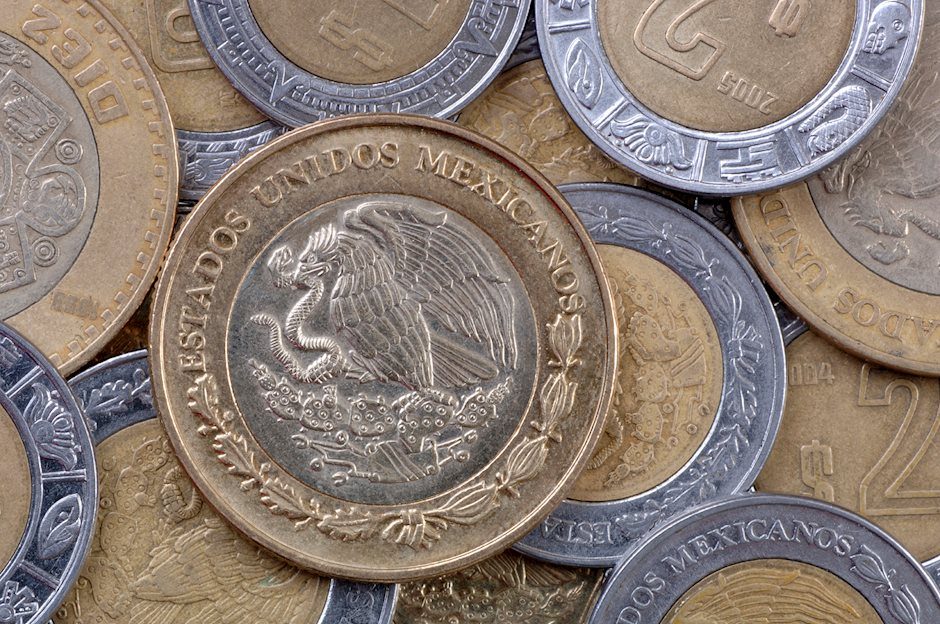Mexican Peso steadily firmed below 18.00 after Wall Street’s posted gains
- Mexican Peso allied shy of testing the 200-day SMA at around 17.80.
- Falling US Treasury bond yields capped the USD/MXN advances, with the pair dropping below 18.00.
- Unless the USD/MXN exotic pair breaks support at 17.80, the risks are tilted to the upside.

Mexican Peso (MXN) registered solid gains vs. the US Dollar (USD) during the last trading hour of the New York session and achieved a daily close below the psychological 18.00 level, which could open the door to re-test the 200-day Simple Moving Average (SMA) at around 17.80.
The USD/MXN headed lower amid a risk-on impulse, as portrayed by Wall Street, finished Wednesday’s session with solid gains while falling US bond yields undermined the Greenback. Therefore, the exotic pair ending the session with losses of 0.67% amidst mixed solid data from the US, and money market futures disregarding a rate hike by the US Federal Reserve (Fed) at the upcoming November meeting could pave the way for further downside.
Daily Digest Market Movers: Mexican Peso rallies late in the North American session
- The Mexican economic docket would feature Consumer Confidence, expected to match August’s 46.7.
- Risk-on impulse stopped the Mexican Peso depreciation, though its bias has shifted bearish.
- The IMF increased Mexico’s growth projection in 2023 from 2.6% to 3.2% and from 1.5% foreseen in July to 2.1% for 2024.
- US ADP Employment figures came at 89,000, below forecasts of 153,000.
- US ISM Services PMI came at 53.6, as foreseen by analysts, though moderately slowed down.
- Mexico’s August remittances were $5,563 million in US Dollars, an advance of 8.6% YoY.
- Banxico’s September poll amongst economists reported that interest rates are expected to remain at 11.25%, while inflation would dip to 4.66%.
- The same poll shows the exchange rate is set to finish at around 17.64, down from 17.75.
- Mexico’s S&P Global Manufacturing PMI for September came at 49.8, sliding to contractionary territory and below August’s 51.2, as the economy loses steam.
- Business confidence in Mexico improved from 53.7 to 53.8.
- Mexico’s economy could slow down due to complex external shocks, according to the financial system stability committee.
- The Bank of Mexico (Banxico) held rates at 11.25% and revised its inflation projections from 3.5% to 3.87% for 2024, above the central bank’s 3% target (plus or minus 1%).
- Banxico’s Government Board highlighted Mexico’s economic resilience and the strong labor market as the main drivers to keep inflation at the current interest rate level.
- Mexico’s Unemployment Rate edged lower from 3.1% in July to 3.0% in August, according to the National Statistics Agency (INEGI).
Technical Analysis: Mexican peso achieved a daily close below 18.00
The Mexican Peso bias shifted to bearish on Tuesday after the USD/MXN pair surpassed the 200-day Simple Moving Average (SMA) at 17.80, and buyers reclaimed the 18.00 figure to post a new cycle high. Therefore, the USD/MXN could extend its rally past the October 4 cycle high at 18.21 and test resistance at the April 5 high at around 18.40 en route to the April 2018 yearly low of 18.60. On the downside, a drop below 18.00 and the 20-day SMA at 17.40 could pave the way for further losses.
Fed FAQs
What does the Federal Reserve do, how does it impact the US Dollar?
Monetary policy in the US is shaped by the Federal Reserve (Fed). The Fed has two mandates: to achieve price stability and foster full employment. Its primary tool to achieve these goals is by adjusting interest rates.
When prices are rising too quickly and inflation is above the Fed’s 2% target, it raises interest rates, increasing borrowing costs throughout the economy. This results in a stronger US Dollar (USD) as it makes the US a more attractive place for international investors to park their money.
When inflation falls below 2% or the Unemployment Rate is too high, the Fed may lower interest rates to encourage borrowing, which weighs on the Greenback.
How often does the Fed hold monetary policy meetings?
The Federal Reserve (Fed) holds eight policy meetings a year, where the Federal Open Market Committee (FOMC) assesses economic conditions and makes monetary policy decisions.
The FOMC is attended by twelve Fed officials – the seven members of the Board of Governors, the president of the Federal Reserve Bank of New York, and four of the remaining eleven regional Reserve Bank presidents, who serve one-year terms on a rotating basis.
What is Quantitative Easing (QE) and how does it impact USD?
In extreme situations, the Federal Reserve may resort to a policy named Quantitative Easing (QE). QE is the process by which the Fed substantially increases the flow of credit in a stuck financial system.
It is a non-standard policy measure used during crises or when inflation is extremely low. It was the Fed’s weapon of choice during the Great Financial Crisis in 2008. It involves the Fed printing more Dollars and using them to buy high grade bonds from financial institutions. QE usually weakens the US Dollar.
What is Quantitative Tightening (QT) and how does it impact the US Dollar?
Quantitative tightening (QT) is the reverse process of QE, whereby the Federal Reserve stops buying bonds from financial institutions and does not reinvest the principal from the bonds it holds maturing, to purchase new bonds. It is usually positive for the value of the US Dollar.
Author

Christian Borjon Valencia
FXStreet
Christian Borjon began his career as a retail trader in 2010, mainly focused on technical analysis and strategies around it. He started as a swing trader, as he used to work in another industry unrelated to the financial markets.
















